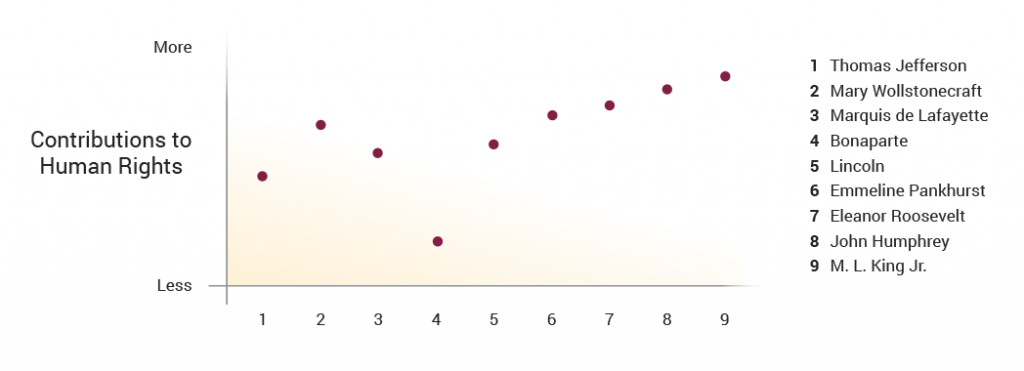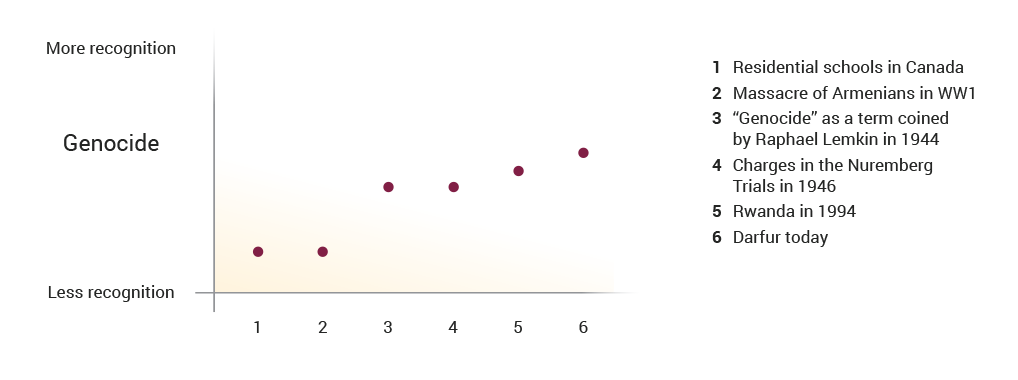Educator Tools

 Ask yourself:
Ask yourself:
- What are human rights? Why are they so important?
- How do we make them a reality in our world today?
![]() Did You Know?
Did You Know?
- Thomas Jefferson wrote 82 drafts before the Declaration of Independence was published.
- The French Declaration of the Rights of Man and of the Citizen was written largely by the Marquis de Lafayette, a veteran of the American War of Independence and a friend of Thomas Jefferson (who may have helped him write the French Declaration).
- The Universal Declaration of Human Rights (UDHR) has been translated into over 400 different languages and is the most translated document ever, according to the Guinness Book of Records.
- The Canadian Charter of Rights and Freedoms influenced the South African Bill of Rights written into its constitution following the end of the apartheid era.
John Peters Humphrey
Which of these human rights documents is connected to the work of Canadian legal scholar John Peters Humphrey? (The answer is at the bottom of this page.)
ACTION 1
Do
A Quiz to Test Your Knowledge
Match the excerpts with the documents by putting the number on the line
| Excerpts from the documents: | Match | Documents |
|---|---|---|
| A. We hold these truths to be self-evident, that all men are created equal, that they are endowed by their Creator with certain unalienable Rights, that among these are Life, Liberty and the pursuit of Happiness. | _______ | 1. Canadian Charter of Rights and Freedoms, 1982 |
| B. Men are born free and remain free and equal in rights . . . These rights are liberty, property, security, and resistance to oppression. | _______ | 2. American Declaration of Independence, 1776 |
| C. All human beings are born free and equal in dignity and rights. They are endowed with reason and conscience and should act towards one another in a spirit of brotherhood. | _______ | 3. The Declaration of the Rights of Man and of the Citizen, France, 1789 |
| D. Everyone has the following fundamental freedoms: a. freedom of conscience and religion; b. freedom of thought, belief, opinion and expression; c. freedom of peaceful assembly; and d. freedom of association | _______ | 4. American Declaration of Independence, 1776 |
(Answers are at the bottom of this page.)
ACTION 2
iSearch
What Are Human Rights?
According to the United Nations, “Human rights are rights inherent to all human beings, whatever our nationality, place of residence, sex, national or ethnic origin, colour, religion, language, or any other status. We are all equally entitled to our human rights without discrimination. These rights are all interrelated, interdependent and indivisible.”
Universal Declaration of Human Rights
- We Are All Born Free and Equal
- Don’t Discriminate
- The Right to Life
- No Slavery
- No Torture
- You Have Rights No Matter Where You Go
- We’re All Equal Before the Law
- Your Human Rights Are Protected by Law
- No Unfair Detainment
- The Right to Trial
- We’re Always Innocent Till Proven Guilty
- The Right to Privacy
- Freedom to Move
- The Right to Seek a Safe Place to Live
- Right to a Nationality
- Marriage and Family
- The Right to Your Own Things
- Freedom of Thought
- Freedom of Expression
- The Right to Public Assembly
- The Right to Democracy
- Social Security
- Workers’ Rights
- The Right to Play
- Food and Shelter for All
- The Right to Education
- Copyright
- A Fair and Free World
- Responsibility
- No One Can Take Away Your Human Rights
Think
As you explore the cases, here are some additional questions to ask yourself:
- Which of the 30 UDHR human rights are accepted in Canada? Which are denied in Canada?
- Can Canada be proud of its human rights record?
ACTION 3
Think
Historical Graphs
We often construct graphs exploring the relationships between prices and demand in economics and sets of demographic data in geography.
Historical graphs add a dimension to traditional timelines by helping us explore the nature and significance of chronology (change over time) in meaningful ways. We can see patterns over time and recognize that history is not an unbroken line of progress or decline.
Historical graphs allow us to construct meaning by making connections between the abstract nature of data and the people and events that lay behind it.
Do
Procedure for Building a Timeline Graph
Begin with a blank 8 1/2” x 11” or 11” x 14” paper.
The horizontal axis usually represents an element of chronology such as: decisions by a leader or a group, or a series of events around a common theme (e.g. strikes, inventions, diary entries or public speeches by a historical figure).
The vertical axis represents some comparative criteria such as:
- unimportant—very important
- more push factor—more pull factor
- good example—poor example
- strongest influence—weakest influence
- more or fewer examples
- more welcoming—less welcoming.

Place the events or a number corresponding to each event on the graph depending on the degree to which the event, quote, feeling, or decision meets the vertical axis criteria.
In this unit, the vertical axis represents a continuum towards the achievement of human rights. The horizontal axis can represent key dates relevant to the cases studied.
After the graphs have been constructed, discussed, and debated, you can write position papers on critical questions such as:
- Has the struggle for human rights been a consistent one?
- What is the trend in the past century or in the past decade in the recognition of human rights?
- How do you account for these trends in the struggle for universal human rights?
Extensions and Resources
In chronological order, the horizontal axis has many options: the significance of historical figures in the struggle for human rights (world history).
The examples below are political/military but we could substitute philosophers, writers, or artists from Confucius to Mary Wollstonecraft.

Here is a hypothetical example of a historical graph for major figures in the history of human rights

If you join the lines you see that progress is not consistent.
Other places for using historical graphs include:
- A chronology of Supreme Court decisions (American history) or cases in Canadian law (Canadian history).
- Key documents in world history such as Magna Carta and the Petition of Rights in England or the Edict of Nantes in France.
- A clipping thesis of events over a period of two weeks to one month. In this case, there could be several graphs representing economic rights, religious rights, or any of the 30 rights identified in the United Nations’ UDHR.
And for some terms such as genocide, a graph such as the one below would generate much discussion.

The site Youth for Human Rights introduces you to a world of resources and ideas for teaching human rights, using the UDHR as the standard. They offer a free online course.
For a more detailed scholarly treatment of the development of human rights, see Lynn Hunt’s Inventing Human Rights: A History (Norton, 2007).
ACTION 4
iSearch
Learn about your province’s Human Rights Commission and human rights laws
CANADIAN PROVINCIAL HUMAN RIGHTS COMMISSIONS
- ONTARIO – http://www.ohrc.on.ca/en/learning/elearning
- QUEBEC – https://cdpdj.qc.ca/en
- BRITISH COLUMBIA – http://www.bchrt.bc.ca/human-rights-duties/index.htm
- ALBERTA – https://www.albertahumanrights.ab.ca/education/Pages/e_learning.aspx
- MANITOBA – http://www.manitobahumanrights.ca/yourhumanrights.html
- SASKATCHEWAN – https://saskatchewanhumanrights.ca/your-rights/saskatchewan-human-rights-code/
- NOVA SCOTIA – https://humanrights.novascotia.ca/content/know-your-human-rights
- NEWFOUNDLAND & LABRADOR – http://www.justice.gov.nl.ca/hrc/about/index.html
- NEW BRUNSWICK – http://www2.gnb.ca/content/gnb/en/departments/nbhrc/human-rights-act/summary.html
- PRINCE EDWARD ISLAND – http://www.gov.pe.ca/humanrights/
- YUKON – http://yukonhumanrights.ca/
- NORTHWEST TERRITORIES – http://nwthumanrights.ca/your-rights/
- NUNAVUT – http://www.nhrt.ca/english/general_information
Canadian Legal Information Institute
Examine human rights legislation on this free website: Canadian Legal Information Institute
To browse the site:
- Enter “human rights” in the first field called “Document text”
- Choose a province or Canada (Federal) under Jurisdiction on the left
- Results will show from the Supreme Court of Canada. Click on each one that is relevant or useful to you. You can choose by All, Cases, Legislation or Commentary (top listing under the empty fields)
Answers to the quiz:
A-2, B-3, C-4, D-1
John Peters Humphrey wrote the first draft of the Universal Declaration of Human Rights.
Every effort has been made to gain permission from copyright holders to reproduce borrowed material. The publishers apologize for any errors and will be pleased to rectify them in subsequent reprints and website programming
Educator Tools



